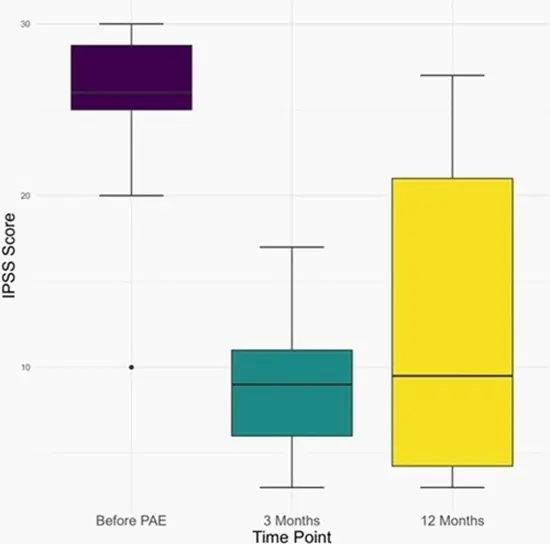Outcomes of Prostatic Artery Embolization for Treating Benign Prostatic Hyperplasia Symptoms: A Prospective Single-Center Study

Background and Aims
Benign prostatic hyperplasia (BPH) is among the most common urologic conditions in elderly men, presenting with lower urinary tract symptoms. Prostatic artery embolization (PAE) is a recent interventional treatment for BPH.
Methods
This prospective single-center study reviewed the results of cases that underwent PAE for BPH from 2020 to 2022. Inclusion criteria were men with BPH refractory to pharmacologic treatment or those experiencing persistent adverse effects from medications, who were not candidates for surgical management. Assessments were made using ultrasonography for prostate volume and the International Prostate Symptom Score (IPSS) before and at 3 and 12 months after PAE. The clinical success rate of PAE was assessed according to the Cardiovascular and Interventional Radiological Society of Europe Standards of Practice. Recurrence of symptoms and complications after PAE were also recorded.
Results
From a total of 46 included patients, clinical success was achieved in 93% at 3 months and 85% at 12 months. Complications occurred in eight (17.4%) cases, including five cases of erectile dysfunction and three cases of urinary tract infection. Eight (17.4%) cases had recurrent symptoms and required pharmacologic treatment, while seven (15.2%) needed surgery. The IPSS score dropped significantly at 3 months, with a mean difference of −16.2 (95% CI: −17.7 to −14.8) (p < 0.001), and at 12 months after PAE, with a mean difference of −13.5 (95% CI: −15.9 to −11.1) (p < 0.001). Prostate volume decreased significantly at 3 months, with a mean difference of −36.0 (95% CI: −43.0 to −29.0) (p < 0.001), and at 12 months, with a mean difference of −37.3 (95% CI: −43.7 to −31.0) (p < 0.001).
Conclusion
The findings of this study indicate that PAE is an effective therapeutic approach for patients with BPH, demonstrated by the low rates of adverse events and the absence of major complications.






comment